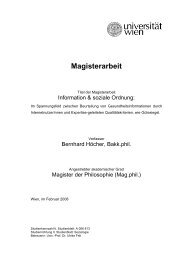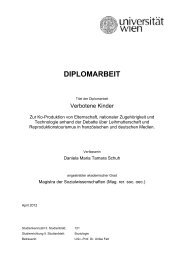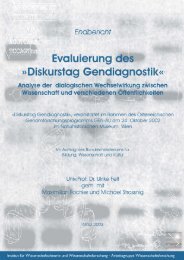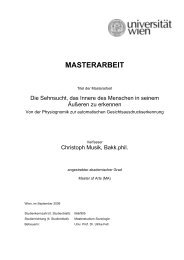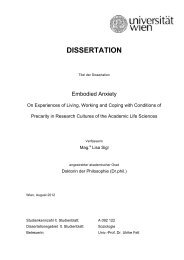MASTERARBEIT - Institut für Wissenschaftsforschung - Universität ...
MASTERARBEIT - Institut für Wissenschaftsforschung - Universität ...
MASTERARBEIT - Institut für Wissenschaftsforschung - Universität ...
You also want an ePaper? Increase the reach of your titles
YUMPU automatically turns print PDFs into web optimized ePapers that Google loves.
4.3 tying together sociotechnical imaginaries and scot 33<br />
results in one social group’s meaning becoming dominant« [2], the<br />
concept of STI allows for a new interpretation. Assuming a new imaginary<br />
»encode[s] and reinforce[s] particular conceptions of what a<br />
nation stands for?« [27, 120], it might just as well be that a new meaning<br />
emerges out of the discourse that then redefines the constitution<br />
of relevant social groups. Going with the United States’ motto ’e<br />
pluribus unum - out of many, one’, the zeppelin could in this way be<br />
depicted as an important factor for the unification of a fragmented<br />
society.<br />
4.3 tying together sociotechnical imaginaries and scot<br />
As the zeppelin case will show, the pursuit of a vision, the development<br />
of a technology not as a reaction to current challenges but as an<br />
effort to push boundaries can be a driving force. The development of<br />
a shared vision can thus open up entirely new technological spaces<br />
(in opposition to gradual development over a large timespan) and<br />
secondly the shared vision can itself, as quoted from Jasanoff above<br />
»encode and reinforce particular conceptions of what a nation stands<br />
for« by providing a piece of shared identity. It is not limited to applying<br />
an existing technology to present challenges, but it enables one to<br />
open up entirely new fields – scenarios that are yet only imaginable<br />
and seem unrealistic.<br />
Imaginaries and their orientation towards the future bring along<br />
some very substantial aspects that greatly enhance the interpretative<br />
flexibility of an artifact. First of all, the point of time at which the<br />
imagined is to become reality can remain indefinite. In other words,<br />
the imaginary has at (almost) no point to be declared as failed - the<br />
vision can rather be adjusted to changing surrounding conditions and<br />
prerequisites. Just as well, time can simply remain opaque: a reference<br />
to the future - whatever that means - can be enough to create an<br />
expectation or make others start imagining themselves. Second, not<br />
only can the vision be adapted. The imagined future can be made<br />
more likely to actually unfold by own actions. These prospects and<br />
actions, however, change the present - and the actor itself as well as<br />
his or her behavior. This active pursuit of one’s future allows for an<br />
actor or a group of them to change and adapt in order to make one<br />
particular vision of the future more likely. Moreover, the futuristic<br />
character of the imaginary frees the vision from the restriction to rely<br />
on existing and/or realistic technologies. As it is about what is going<br />
to be, not what is, the range of what can be envisioned increases<br />
dramatically. Technological development has not to be thought in<br />
consecutive steps but can be seen from the end - which might ease<br />
engagement into a long process in contrast to seeing the process from<br />
the beginning. Thus those imaginaries can be ahead of their time and



